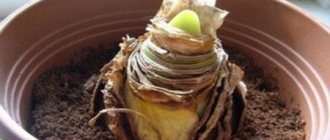Features of growing tulips
The homeland of these magnificent flowers is Asia, where spring comes early, followed by hot summers, often very dry. Plants are adapted precisely to this cycle: awakening at the beginning of spring, then a new growing season, then a state of dormancy.
If you want to see a flower bed in bloom, then you should support this life cycle of fragile flowers:
- After flowering in the spring, you need to wait until all the petals fall off.
- Then the stems should be removed, preventing the seed pod from ripening.
- The last step is digging up the bulbs and storing them until planting.
Secrets of caring for bulbous bulbs
There is not a single person who would indifferently walk past a blooming flowerbed with tulips, especially if there is a whole dance of these noble flowers in the flowerbed.
But tulips do not always bloom so wildly. They may not bloom the next year or may not bloom as profusely. These pampered plants require special attention. Flower growers need to know the secrets of caring for delicate plantings.
Should I cut off the leaves after flowering?
The first thing that worries flower growers is whether they need to cut off the leaves after the tulips bloom. After the picturesque picture, the yellowed leaves and faded buds really take on a completely unattractive appearance.
What to do with the leaves? There is no need to rush into pruning, because nutrients are supplied to the bulbs through the foliage. You must be prepared for the fact that caring for these plants will take about 2-3 weeks.
And so that faded tulips do not spoil the appearance of the flowerbed, plant perennials between them. These can be long-blooming phloxes.
Leave the leaves and stems after yellowing, otherwise the process of bulb formation will stop. Experts advise not to cut them, but to tear them off with your hands. Why is this being done? If the leaves come off poorly, it means the bulb is not yet ripe. Wait until the leaf is easily pulled out of the ground.
If you remove the foliage prematurely, then next year you may not wait for the lush opening of the buds due to poor ripening of the bulbs.
Boxes with seeds
But the seed pods need to be trimmed. The remaining seed pods will draw energy and nutrients from the bulbs, weakening them so that they will not be able to release a flower stalk.
They are removed after the petals have completely withered and fallen off. This happens 5-8 days after the bud opens. It all depends on the type of flowers.
If you really like the variety, cut off the flower heads 7-8 days after the start of flowering. Try not to let them fall off. What to do with them? You can plant it in the ground, but you will have to wait 5 years for flowering in open ground, so these flowers are bred by dividing those bulbs that form in the ground.
Another trick for gardeners: to avoid losing the place where they were located after the tulips bloom and dry, place a beautiful flag.
At what point after flowering is pruning done?
Flower growers need to follow two rules when pruning tulips:
- Wait until the petals of the bud are dry and can be easily separated from the stem;
- Trim the stem to the leaves, leaving a mark so that the bulb can be easily found when digging it up.
Before pruning, it is necessary to disinfect the tools with alcohol or a special liquid based on potassium and vitriol. Use a clean cloth or napkin to remove excess moisture from the scissors, pruning shears or knife.
What to do with tulips in pots?
The facade of the house, decorated with flowers in a pot, looks very beautiful. Recently, this hobby has become especially popular. What to do with the plant after wilting:
- You also need to water until the stems completely dry out.
- After waiting for the bulb to go into a dormant state, it must be dug up.
- Then dry it, put it in a dry box, and store it until September. You can wrap it in paper and transfer it to the lower section of the refrigerator.
- In September, plant together with the rest of the bulbous plants.
If you take care of bulbous plants from early spring to late autumn, they will definitely delight you with their beauty.
How to avoid mistakes with digging
Some gardeners are convinced that tulip bulbs will overwinter well in the ground. This is a fundamentally wrong decision. The question: whether to dig up bulbs for storage requires an immediate answer. Bulbs require annual digging and here's why.
An undug bulb will sink lower into the ground every year. In order for it to germinate next year, it needs a lot of strength and nutrients. Also, from one bulb, several more appear in the nest. They are so crowded in a dense nest that it is difficult for them to grow to the surface.
Several years will pass and the tulip growing in one place will lose its varietal properties. The buds will become small, weakened, and will no longer delight with lush flowering. Even worse, he could die.
If you don’t want to lose varietal flowers, you should definitely dig them up. Regular tulips can be transplanted into bulb pots.
Why apply fertilizer to wilting plants?
Caring for tulips after flowering requires timely application of fertilizers. The fact is that the development process is still ongoing. And the appearance of the flowers next spring will depend on how lazy the gardener takes the time to water and feed the fading flowerbed with special fertilizers. The flowerbed should be watered as needed for another two weeks after cutting the flower stalks. You only need to fertilize the soil once. It would be enough. You can choose regular mineral fertilizers for bulbous plants. But the dosage must be reduced by half from the recommended one in order to prevent chemical burns to the cells. A phosphorus-potassium mixture is also suitable. Do not use fertilizers that contain nitrogen or chlorine.
How to care after digging
When to dig? Digging is usually carried out before the end of July. It is during this period that the tulips dry out.
But here, too, not everything is so simple. You need to dig a little and find a few bulbs. If a brown husk has formed on them, then they are fully ripe.
After you are sure that the bulbs are ripe, dig them up without mixing up the varieties.
Make the shovel deeper so as not to touch the roots. Shake the bulbs off the ground and place them on a flat surface for inspection. Remove spoiled seeds and immerse healthy ones in a weak solution of potassium permanganate. Leave it there for 20 minutes and then lay it out again to dry. Potassium permanganate will destroy pathogenic spores.
When should you replant daffodils?
These flowers can live in one place for up to five years. You should not disturb them for annual replanting, otherwise the plants may not bloom so abundantly. But if the stems begin to crowd together and have already grown quite strongly, then it’s time to plant them.
Read also: Onion peels: beneficial properties, contraindications and recipes
For transplant you will need:
- garden trowel;
- gloves;
- disinfecting solution.
Daffodil bushes are planted immediately; young roots should not be allowed to dry out. Choose a late afternoon in early August, when the midday heat has subsided, and get started.
What do we have to do?
1) To begin with, carefully dig up the bushes.
2) Then they are divided into smaller ones and laid out for processing.
3) For prevention, plants can be sprayed with a weak solution of potassium permanganate or a suitable fungicide.
4) In a new location, prepare the holes and transplant the daffodils into them with the utmost care.
Do I need to divide the onions?
This process must be carried out in any case. How to divide the bulbs after the tulips bloom? Small ones grow around the large nodule, which must be separated. If it’s a pity to throw them away, then dry them, and in September plant them in boxes with nutritious soil. Perhaps at home they will produce strong shoots by spring.
If you manage to grow plants from small nodules, transplant them into open ground in the spring. True, no one can guarantee that the variety you wanted to grow will survive.
Planting should be done only when the ground warms above 10 degrees Celsius. Many gardeners plant as seedlings when the ground warms up enough and frost will not return. In this case, the seedlings can be transferred to a permanent place.
How to store tulip nodules
How to preserve the bulbs of these delicate plants before planting in the ground:
- First, the onions are placed under a canopy for ventilation. It should be warm and dry there.
- After a few days, you can remove the stuck soil; there is no need to peel off the skin.
- Leave to dry for another 20 days.
- If the material has not been sorted, then it’s time to start sorting. Place the largest ones separately.
- At the same time, sort by variety.
- Place the bulbs in special boxes with a bottom that is well ventilated. This way you will protect the material from rot.
- Review the planting material from time to time. You won't have to store it for long, but even during this time it may deteriorate.
Plant large-caliber material separately, and medium-caliber material separately. Thanks to this division, the bed will remain in bloom for a long time, because flowering of different sizes of material will occur at different times.
Is it possible to plant tulips and daffodils together?
Is it possible to plant tulips and daffodils next to each other? No you can not. Daffodils have a detrimental effect on tulips. They should not be placed in the same vase, since the milky juice of daffodils will cause the tulip flowers to wither.
Interesting materials:
How to issue a power of attorney to receive a parcel? How to format a letter in English Oge? How to limit calls on Instagram? How to characterize a good employee? How to cool tulip bulbs? How are warehouse walls painted? How to fumigate a basement with sulfur? How does the social insurance fund and the employer pay for sick leave? How is travel on duty paid? How is vacation paid by law?
When is the time to plant tulips?
At the end of September or beginning of October, in sunny weather, transplantation into the soil occurs. Before planting, they must be kept in a manganese solution again. Find a new spot in the garden and begin this important work.
How to properly transplant to a flowerbed:
- Make a hole approximately 8 centimeters deep;
- Water generously, plant the bulb, cover with soil;
- A week after the planting procedure, sprinkle the soil with ash and pour in a solution of ammonium nitrate;
- Lay down mulch. You can cover the bed with a thin layer of peat.
When to dig up bulbs?
It is not advisable to leave tulip bulbs in the ground all the time, so it is recommended to dig them up every year. After flowering has completed, you can remove planting material from the ground no earlier than all the leaves, peduncles and stems have been cut off.
The most suitable period for digging up tulip planting material is summer, namely the last week of the 1st month or the beginning of the 2nd. The procedure can only be carried out in dry, preferably sunny weather. First of all, you need to dig up the early varieties of flowers, and later the later ones.
What to do next with them? Bulbs cleared of soil should be carefully inspected for rot or other damage. If the tuber is soft or watery, then it should be thrown away, since the flower will not grow again from such a bulb. Healthy planting material should be dense, with regrown roots and brownish scales. Then the strong bulbs should be immersed in a solution of potassium permanganate (5%) for about 3-5 minutes. After this, lay the planting material on a flat surface and allow to dry.
Bulbs must be properly stored until the next planting in the garden or bed. A spacious box in which air can circulate, for example, with a mesh bottom, is suitable for storage. The bulbs can be individually wrapped in thick newsprint. Then the planting material is laid out in a box, possibly even in two layers. After this, the box will need to be removed to a warm place with low humidity and temperature:
- 1st month within 22 to 26 degrees Celsius;
- 2nd – from 20 to 22 degrees Celsius;
- 3rd – 15-17 degrees Celsius.
Sudden changes in temperature should not be allowed, as this may cause the bulbs to die or weaken.
When to feed tulips
These delicate fragile plants are very demanding when it comes to feeding. Moreover, the flowerbed will have to be fertilized 3 or 4 times per season. First in early spring, as soon as the soil thaws a little. The second time when the buds appear. The third time - for lush flowering. And the fourth - after dropping the petals.
How to fertilize plants: first of all, they need nitrogen. Then they will need phosphorus and potassium. If the leaves begin to die, you should feed them with magnesium. Are the buds setting poorly? Requires calcium fertilizer.
It is best to feed with complex fertilizer Kemira, Universal-2. After watering, many gardeners sprinkle dry fertilizers at the rate of 30 g per 1 square. After the third sheet unfolds, the manipulation should be repeated. For the third feeding, take superphosphate: 20 g per 1 sq.m.
What will grow after tulips
After the bulbs are dug up, there will be an empty space. And it’s only June, there’s a whole summer ahead. What to plant after these flowers? Will do
- any seedlings of annual flowers: asters, purslane, tagetes, ageratum;
- perennials grown from seeds;
- decorative cabbage;
- indoor potted flowers (pelargonium, kala, coleus).
Tulips can be planted near hosta bushes. When the tulips calm down, the hosta will begin to reveal its gorgeous leaves. The foliage of this plant will cover the empty ground without disturbing the beauty of the garden.
Dear friends, there are many recommendations on what to do with tulips after flowering. Take the advice of experienced flower growers and admire the lush flower beds of these magnificent flowers for a long time.
Leaf cutting
Daffodils, as close relatives, require the same care at the end of spring as care for tulips after flowering. If all the gardener’s actions at this time are arranged sequentially, then they will be in this order:
- flowers are cut to form bouquets or allowed to wither naturally;
- in the second case, the seed capsule is torn off after the petals fall;
- in the last days of spring, special fertilizers are added to the soil, not forgetting to water the bed;
- leaves are picked off only after drying;
- Afterwards the bed is mulched with peat or wood ash.











